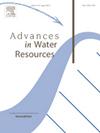Semi-analytical solutions for flow with space or time-varying viscosity in fractured porous media
IF 4.2
2区 环境科学与生态学
Q1 WATER RESOURCES
引用次数: 0
Abstract
Some polymer solutions can form a gel when injected into a porous medium. These gel-forming solutions are of great interest for specific applications such as improving the geotechnical characteristics of soils and enhancing the recovery of contaminants or oil from fractured reservoirs. During its travel through porous media, the viscosity of the gelling solution increases, which can significantly affect its hydraulic properties. This work considers the injection of a gelling polymer, whose viscosity varies in space or time, into a system of two fractures with different apertures. Semi-analytical solutions are developed to describe the evolution of velocity as well as the position of the gelling solution front inside each fracture. The developed semi-analytical solutions are useful to investigate the effect of different parameters as demonstrated by the global sensitivity analysis carried out. GSA results show that fluid velocity inside fractures has different influencing parameters over time. Increasing the viscosity of the gelling fluid reduces the gap between the arrival times of the gelling fluid passing through the large and thin fractures.
The semi-analytical solutions can also serve for the validation of numerical models simulating variable viscosity flow in fractured media, as we demonstrate with an in-house code.
裂缝性多孔介质中空间或时变黏度流动的半解析解
一些聚合物溶液注入多孔介质时可以形成凝胶。这些凝胶形成解决方案对于改善土壤的岩土特性和提高裂缝性油藏中污染物或石油的采收率等特定应用非常有意义。在通过多孔介质的过程中,胶凝液的粘度增加,对胶凝液的水力性能有显著影响。这项工作考虑将黏度随空间或时间变化的胶凝聚合物注入到具有不同孔径的两个裂缝系统中。开发了半解析解来描述速度的演变以及胶凝溶液前缘在每个裂缝内的位置。所建立的半解析解可用于研究不同参数的影响,并通过所进行的全局灵敏度分析得到了证明。GSA结果表明,裂缝内流体速度随时间的变化具有不同的影响参数。增加胶凝液的粘度可以减小胶凝液通过大裂缝和细裂缝到达时间之间的间隔。
本文章由计算机程序翻译,如有差异,请以英文原文为准。
求助全文
约1分钟内获得全文
求助全文
来源期刊

Advances in Water Resources
环境科学-水资源
CiteScore
9.40
自引率
6.40%
发文量
171
审稿时长
36 days
期刊介绍:
Advances in Water Resources provides a forum for the presentation of fundamental scientific advances in the understanding of water resources systems. The scope of Advances in Water Resources includes any combination of theoretical, computational, and experimental approaches used to advance fundamental understanding of surface or subsurface water resources systems or the interaction of these systems with the atmosphere, geosphere, biosphere, and human societies. Manuscripts involving case studies that do not attempt to reach broader conclusions, research on engineering design, applied hydraulics, or water quality and treatment, as well as applications of existing knowledge that do not advance fundamental understanding of hydrological processes, are not appropriate for Advances in Water Resources.
Examples of appropriate topical areas that will be considered include the following:
• Surface and subsurface hydrology
• Hydrometeorology
• Environmental fluid dynamics
• Ecohydrology and ecohydrodynamics
• Multiphase transport phenomena in porous media
• Fluid flow and species transport and reaction processes
 求助内容:
求助内容: 应助结果提醒方式:
应助结果提醒方式:


